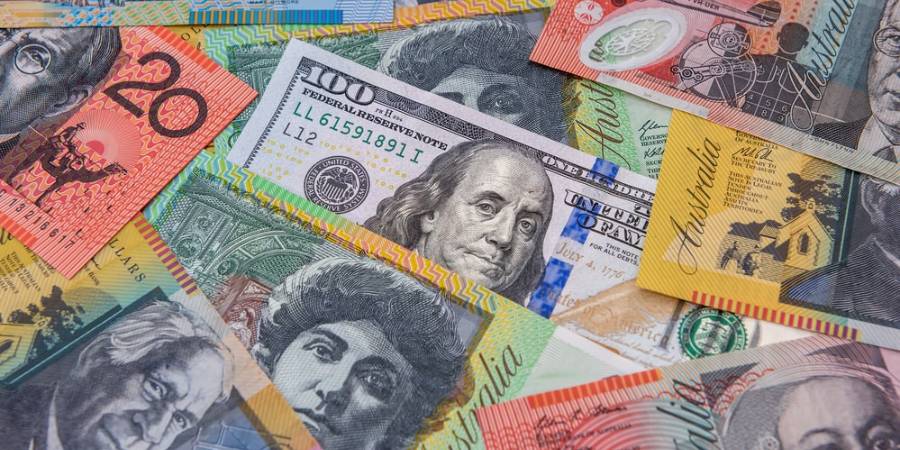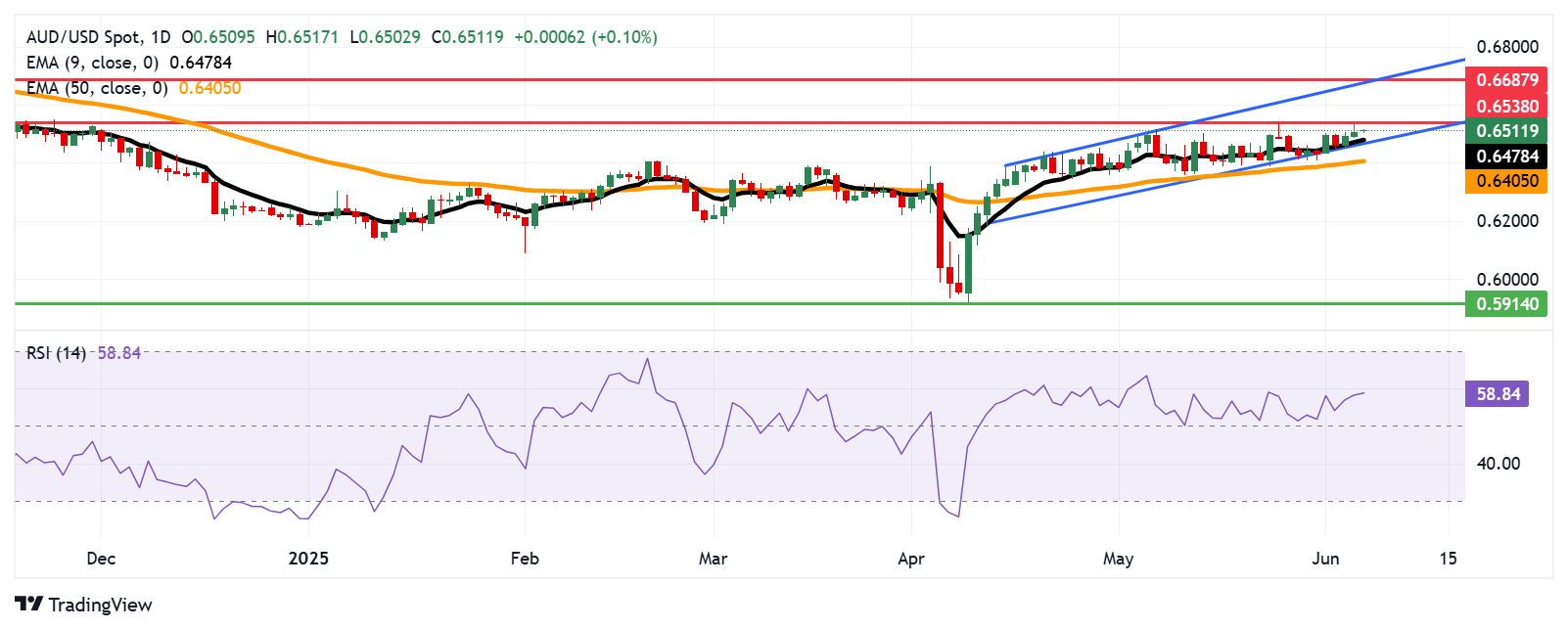Australian Dollar extends gains as sentiment improves following a Trump-Xi phone call

The Australian Dollar holds gains, potentially driven by a productive phone call between Donald Trump and Xi Jinping.
President Trump described the call as productive, and negotiations on tariffs are set to continue.
US Nonfarm Payrolls could have added 130,000 jobs in May, meanwhile, the Unemployment Rate is expected to hold steady at 4.2%.
The Australian Dollar (AUD) advances against the US Dollar (USD) on Friday, extending its winning streak for the third successive day. Traders await the upcoming US Nonfarm Payrolls (NFP) report, due later in the day, seeking fresh insights into the United States (US) economy.
Market sentiment improved following a productive phone call between US President Donald Trump and Chinese President Xi Jinping. Trump expressed that the call was productive and prepared to continue tariff negotiations. However, Trump and his team struggled to stay composed with Chinese trade officials. It is essential to note that any changes in the Chinese economy could impact the AUD, as China and Australia are close trade partners.
Reserve Bank of Australia (RBA) Minutes of its May meeting suggested that the policymakers viewed the case for a 25 basis point cut as stronger, preferring a policy to be cautious and predictable. RBA Assistant Governor Sarah Hunter expressed caution on Tuesday that “higher US tariffs will put a drag on the global economy,” and warned that higher uncertainty could dampen investment, output, and employment in Australia.
Australian Dollar edges higher as US Dollar struggles ahead of Nonfarm Payrolls
The US Dollar Index (DXY), which measures the value of the US Dollar against six major currencies, is trading lower at around 98.70 at the time of writing. The upcoming US Nonfarm Payrolls is expected to have added 130,000 jobs in May, below the 177,000 increase in April. The Unemployment Rate is also expected to hold steady at 4.2%.
Weekly Initial Jobless Claims rose to 247,000, above the expected 235,000, as data released by the US Department of Labor. Thursday’s US ADP private sector employment rose 37,000 in May, against a 60,000 increase (revised from 62,000) recorded in April, far below the market expectation of 115,000.
Institute for Supply Management's (ISM) Services Purchasing Managers Index (PMI) declined to 49.9 in May, from 51.6 in April. This reading surprisingly came in weaker than the expected 52.0. Meanwhile,
US President Donald Trump called upon, in a post published on Truth Social on Wednesday, Federal Reserve (Fed) Chairman Jerome Powell to lower the policy rate. "ADP NUMBER OUT!!! “Too Late” Powell must now LOWER THE RATE. He is unbelievable!!! Europe has lowered NINE TIMES," Trump said.
On Wednesday, Minneapolis Fed President Neel Kashkari noted that the labor market is showing some signs of slowing down. However, persistent uncertainty prevails over the economy, and the Fed must stay in wait-and-see mode to assess how the economy responds to the uncertainty.
House Republicans passed Trump’s “Big Beautiful Bill,” a multitrillion-dollar tax and spending package, which could increase the US fiscal deficit, along with the risk of bond yields staying higher for longer. This scenario raises concerns over the US economy and prompts traders to sell American assets under the “Sell America” trend. Policy experts anticipate Senate changes as GOP lawmakers aim to finalize the “big bill” by July 4.
The former biggest Donald Trump backer, Elon Musk, has been attacking Trump’s ‘big beautiful budget bill’ this week via social media. Musk has been openly mocking the Trump budget, which he had played a key role in creating. He criticized that the Trump budget codifies functionally none of the federal spending cuts that he swiftly executed at the start of Trump’s second term without Congressional oversight.
Last week, Trump accused China of breaching a truce on tariffs reached earlier this month. Washington and Beijing agreed to temporarily lower reciprocal tariffs in a meeting in Geneva. Trump said that China had "totally violated its agreement with us." US Trade Representative Jamieson Greer also said that China had failed to remove non-tariff barriers as agreed. In response, a spokesperson from China’s Ministry of Commerce said on Monday that China had complied with the agreement by cancelling or suspending relevant tariff and non-tariff measures aimed at US "reciprocal tariffs."
China's Caixin Manufacturing Purchasing Managers' Index (PMI) unexpectedly fell to 48.3 in May from 50.4 in April, falling short of the market expectations of a 50.6 expansion. However, the weekend data showed that the National Bureau of Statistics (NBS) Manufacturing PMI rose to 49.5 in May, from April’s 49.0 reading. Meanwhile, the Non-Manufacturing PMI declined to 50.3 from the previous 50.4 figure, falling short of the expected reading of 50.6. The Aussie Dollar could be impacted by Chinese economic data as both countries are close trading partners.
Australia’s Trade Balance posted a 5,413M surplus month-over-month in April, below the 6,100M expected and 6,892M (revised from 6,900M) in the previous reading. Exports declined by 2.4% MoM in April, against a 7.2% rise prior (revised from 7.6%). Meanwhile, Imports rose by 1.1%, compared to a decline of 2.4% (revised from -2.2%) seen in March. China’s Caixin Services PMI rose to 51.1 in May as expected, from 50.7 in April.
The Australian Bureau of Statistics (ABS) showed that Gross Domestic Product (GDP) grew by 0.2% quarter-over-quarter in Q1, declining from the previous 0.6% growth. Australia’s economy fell short of the expected 0.4% rise. Meanwhile, the annual GDP growth rate remained consistent at 1.3%, below the expected 1.5%.
Australian Dollar stays above 0.6500, could target seven-month highs
The AUD/USD pair is trading around 0.6510 on Friday. The daily chart’s technical analysis suggests the prevailing bullish bias as the pair remains within the ascending channel pattern. Additionally, the short-term price momentum remains stronger as the pair stays above the nine-day Exponential Moving Average (EMA). The 14-day Relative Strength Index (RSI) is also positioned above the 50 mark, suggesting a bullish outlook.
On the upside, the AUD/USD pair may target a seven-month high of 0.6538, which was recorded on June 5. The pair can also explore the region around the upper boundary of the ascending channel around 0.6680, aligned with the eight-month high at 0.6687.
The primary support appears at the nine-day EMA of 0.6478, aligned with the ascending channel’s lower boundary around 0.6470. Further decline could weaken the bullish bias and lead the AUD/USD pair to test the 50-day EMA at 0.6405.
AUD/USD: Daily Chart

Australian Dollar PRICE Today
The table below shows the percentage change of Australian Dollar (AUD) against listed major currencies today. Australian Dollar was the strongest against the Swiss Franc.

The heat map shows percentage changes of major currencies against each other. The base currency is picked from the left column, while the quote currency is picked from the top row. For example, if you pick the Australian Dollar from the left column and move along the horizontal line to the US Dollar, the percentage change displayed in the box will represent AUD (base)/USD (quote).
* The content presented above, whether from a third party or not, is considered as general advice only. This article should not be construed as containing investment advice, investment recommendations, an offer of or solicitation for any transactions in financial instruments.


